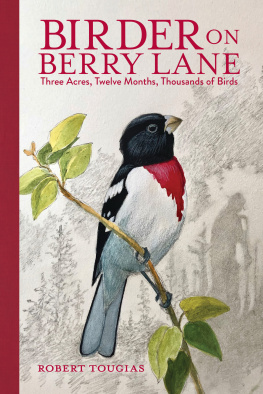Copyright 2019 by Kenn Kaufman
2019 by Kenn Kaufman
2019 by Kenn Kaufman unless otherwise noted
Kimberly Kaufman Used by permission. All rights reserved.
2018 Board of Regents of the University of Wisconsin System. Used by permission of UWMadison AOS Department. All rights reserved.
All rights reserved
For information about permission to reproduce selections from this book, write to or to Permissions, Houghton Mifflin Harcourt Publishing Company, 3 Park Avenue, 19th Floor, New York, New York 10016.
hmhbooks.com
Library of Congress Cataloging-in-Publication Data
Names: Kaufman, Kenn, author.
Title: A season on the wind : inside the world of spring migration / Kenn Kaufman.
Description: Boston : Houghton Mifflin Harcourt, 2019.
Identifiers: LCCN 2018042564 (print) | LCCN 2018052904 (ebook) | ISBN 9781328566768 (ebook) | ISBN 9781328566423 (hardcover)
Subjects: LCSH: BirdsMigrationNorth America. | BirdsEffect of human beings onNorth America. | BirdsConservationNorth America. | BirdsOhioMagee Marsh Wildlife Area. | Magee Marsh Wildlife Area (Ohio)
Classification: LCC QL698.9 (ebook) | LCC QL698.9 .K368 2019 (print) | DDC 598.156/8dc23
LC record available at https://lccn.loc.gov/2018042564
Cover design by Brian Moore
Cover photographs Stefano Garau / Getty Images
Author photograph Delores Cole
v1.0319
Prologue
Pilgrims at the Gates of Sunrise
Last night they were on the move.
They had been waiting. Yesterday and days before they had been scattered in a million hiding places, biding their time. For four days, while cold rain pelted down, they had lurked unnoticed, waiting, resting, building their strength. But yesterday the rain had cleared and a south wind had moved in. So after sunset, as the last glow died on the western horizon, they had arisen all at once. They were a multitude of independent invaders, linked by nothing but an intense awareness, taking to the sky, swarming north.
Flying through the night sky, they could see lights below, both near and distant. Vast fields of light marked Cincinnati, Dayton, Columbus, although the names meant nothing to them. Smaller patches of light glowed everywhere. But these travelers would not have considered navigating by the lights below. They looked up at lights overhead, at the stars arrayed across the black velvet dome of the sky. Those were the reliable guides. Cities, after all, might rise and fall, but the constellations overhead would persist, pointing the way for those who could read the sky.
Most humans on the ground below were utterly unaware of the abundance of life passing overhead. But this springtime movement of migratory birds was nothing new. Birds had flown north across this landscape before there were any electric lights, even before there were scattered campfires. They flew before names like United States and Ohio were first used, and before any calendars called this the second week of May. They flew before the human ideas of weeks and months were invented. The routes and seasons of their travels varied over long spans of time as sea levels rose and fell, as ice sheets advanced and retreated, but the basic movement of migration began millennia ago, its origins lost in the mist of prehistory.
In the last few centuries humans have made sweeping changes to the landscape. There is now less room for wild birds, there are fewer places for them to raise their young, and the northward spring flights are only a shadow of what they once were. But even these diminished flights are still astounding. On peak nights in spring tens of millions of birds, representing hundreds of different species, are moving north all across the continent. During the course of the season migrating birds fly over every square mile of land in North America. Some flying north, some northeast, some northwest, mostly navigating as individuals and not as flocks, they form a living, seething layer of life, far above the ground, for as long as the night lasts.
Most humans are completely oblivious to the feathered parade in the night sky. But some of us are keenly aware. We have been watching weather patterns all season, looking for nights like this with prime conditions. Last night after dark we went online to look at Doppler radar: as small as these birds are, their sheer numbers show up on weather radar, indicating to us when birds are actively moving. Later in the night we went outdoors to listen, and we could hear the occasional flight calls of small birds, drifting down from a thousand feet in the air. And before daylight this morning we headed out to the lakeshore, eager to be there at dawn, to watch for the arriving migrants.
The birds coming from the south, flying a few hundred feet up in the last hours of the night, will see hints of what lies ahead even before first daylight. Below, the velvety blackness of the land is broken only by the isolated lights around farmhouses and small towns and the larger glow from distant cities. But up ahead, moonlight or starlight glints on water, a vast swath of water stretching toward the north: humans call it Lake Erie, one of the Great Lakes. The flying birds see it miles before they reach it, and they may start to drop a little lower, as if calculating whether to end their nights journey before coming to the waters edge.
As the glow increases on the eastern horizon, the scene ahead comes into focus. Beyond the solid darkness of land, light reflects on ragged patches of water punctuated by grass and trees and dikes and roads, a broad band of waterlogged land stretching away to both the west and the east. Just beyond that is a darker line of the beach ridge, and past that ridge nothing but miles of open water.
If they had reached this point earlier in the night, the birds would have kept going, powering on across the lake. With dawn approaching, their calculation changes. If its clear weather, the migrants can see a few islands in the lake, and probably the far shorein most places here its less than thirty miles across the lake to the shoreline in Ontario. But if the birds have been flying all night, most of them will stop now, dropping into cover or swooping down to fly parallel to the lake, not across it.
All over eastern North America at this moment, or at least all along the advancing edge of daylight, migrating birds are dropping out of the sky and looking for cover. In most places they are so widely dispersed that theyll go unnoticed. But here, up against the barrier of the lake, numbers build as more and more birds pause and then come down before the waters edge. In the trees, in the thickets, in the marsh edges, the arriving birds pile up. In the immediate vicinity of the lakeshore, so many small birds will concentrate that theyll be impossible to ignore.
Thats why the people are heading to the lakeshore now.
The sun is just climbing above the horizon and cars are arriving in a steady stream, coming north past the woodlots and ponds of the state wildlife area, north along the low causeway that crosses the broad marsh, following the road as it turns left onto the beach ridge and enters the long, narrow parking lot between the woods and the lake. This parking lot will hold hundreds of carsthe adjacent lakeshore used to be a popular swimming beach, when the area was part of a state parkand by 10 A.M. the lot will be filled to capacity, with more vehicles parked in the grassy overflow lot to the east. All of these humans are coming here for just one reason: to witness the swarms of birds now arriving from the south.
We might expect it to look like a mob scene. But it doesnt. In the early morning light, people are scattered out all along the quarter-mile edge between the parking lot and the woodsgroups of two or three or a dozen people, moving slowly, talking quietly, looking intently at the trees. A boardwalk loops through the woods, with entrances near the east and west ends of the parking lot, and some people have gone that way already, vanishing into the trees. The overall feeling is peaceful but intense, quiet but brimming with possibility.















